Time-Lag of Seasonal Effects of Extreme Climate Events on Grassland Productivity Across an Altitudinal Gradient in Tajikistan
Abstract
1. Introduction
2. Materials and Methods
2.1. Study Area
2.2. Data Sources
2.3. Research Methods
2.3.1. Simulation of NPP Based on CASA Model
2.3.2. Description of Extreme Climate Indices
2.3.3. Slope Analysis
2.3.4. Coefficient of Variation
2.3.5. Geographical Detector
2.3.6. Lag Effect Analysis
3. Results
3.1. Spatiotemporal Variations in Grassland NPP
3.2. Spatiotemporal Variations in Extreme Climate Indices
3.3. Detection of Factor Influence
3.4. Time-Lag Effect of Extreme Climate Indices on Grassland Vegetation
4. Discussion
4.1. Contextualizing Our Findings with Previous Work
4.2. Driving Factors of Seasonal Extreme Climate Events on Grassland Vegetation in Tajikistan
4.3. Time-Lag Effects of Seasonal Extreme Climate Events on Grassland Growth
4.4. Uncertainties
5. Conclusions
- Over the past 22 years, the grassland NPP in Tajikistan has shown a slightly increasing trend [0.01 gC/(m2·a)]. Most extreme temperature indices have shown a growing trend, with TXn, TNn, TR20, and HW all showing significant upward trends (p < 0.01). Most extreme precipitation indices have shown a decreasing trend (except for CDD), with CDD and CWD exhibiting significant trends;
- In low-altitude regions, the interaction between extreme drought and high-temperature events has a significant impact on grassland productivity. In contrast, in mid-to high-altitude areas, extreme temperature events, particularly low-temperature events, can inhibit grassland photosynthesis and growth cycles even though precipitation is relatively abundant;
- In low-altitude areas, the lag time of the effect of seasonal extreme climate events on grassland NPP ranges from 2 to 3 months, while in mid-altitude areas, the lag time is primarily 2 months. Additionally, we found that the lag time of the effect of FD on grassland NPP was 3 months in areas at altitudes of <500 m, 500–1000 m, and 2000–3000 m. Similarly, the lag time of the effect of PA on grassland NPP was a significant 2 months (p < 0.05) in the 1000–3000 m elevation bands.
Supplementary Materials
Author Contributions
Funding
Data Availability Statement
Conflicts of Interest
References
- Piao, S.L.; Zhang, X.P.; Chen, A.P.; Liu, Q.; Lian, X.; Wang, X.H.; Peng, S.S.; Wu, X.C. The impacts of climate extremes on the terrestrial carbon cycle: A review. Sci. China Earth Sci. 2019, 62, 1551–1563. [Google Scholar] [CrossRef]
- Gampe, D.; Zscheischler, J.; Reichstein, M.; O’Sullivan, M.; KSmith, W.; Sitch, S.; Buermann, W. Increasing impact of warm droughts on northern ecosystem productivity over recent decades. Nat. Clim. Chang. 2021, 11, 772–779. [Google Scholar] [CrossRef]
- Ciais, P.; Reichestein, M.; Viovy, N.; Granier, A.; Ogée, J.; Allard, V.; Aubinet, M.; Buchmann, N.; Bernhofer, C.; Carrara, A.; et al. Europe-wide reduction in primary productivity caused by the heat and drought in 2003. Nature 2005, 437, 529–533. [Google Scholar] [CrossRef] [PubMed]
- Li, C.L.; Wang, J.; Hu, R.C.; Yin, S.; Bao, Y.H.; Ayal, D.Y. Relationship between vegetation change and extreme climate indices on the Inner Mongolia Plateau, China, from 1982 to 2013. Ecol. Indic. 2018, 89, 101–109. [Google Scholar] [CrossRef]
- Zhang, Y.M.; Lu, Y.; Sun, G.L.; Li, L.; Zhang, Z.H.; Zhou, X.G. Dynamic Changes in Vegetation Ecological Quality in the Tarim Basin and Its Response to Extreme Climate during 2000–2022. Forests 2024, 15, 505. [Google Scholar] [CrossRef]
- Wei, X.N.; He, W.; Zhou, Y.L.; Ju, W.M.; Xiao, J.F.; Li, X.; Liu, Y.B.; Xu, S.H.; Bi, W.J.; Zhang, X.Y.; et al. Global assessment of lagged and cumulative effects of drought on grassland gross primary production. Ecol. Indic. 2022, 136, 108646. [Google Scholar] [CrossRef]
- Rogiers, N.; Conen, F.; Furger, M.; Stockli, R.; Eugster, W. Impact of past and present land-management on the C-balance of a grassland in the Swiss Alps. Global Change Biol. 2008, 15, 2613–2625. [Google Scholar] [CrossRef]
- Guo, W.W.; Huang, S.Z.; Huang, Q.; Leng, G.Y.; Mu, Z.X.; Han, Z.M.; Han, Z.M.; Wei, X.T.; She, D.X.; Wang, H.Y.; et al. Drought trigger thresholds for different levels of vegetation loss in China and their dynamics. Agric. For. Meteorol. 2023, 331, 109349. [Google Scholar] [CrossRef]
- Wu, L.Z.; Zhao, C.Y.; Li, J.Y.; Yan, Y.Y.; Han, Q.F.; Li, C.F.; Zhu, J.T. Impact of extreme climates on land surface phenology in Central Asia. Ecol. Indic. 2023, 146, 109832. [Google Scholar] [CrossRef]
- Ma, M.Y.; Wang, Q.M.; Liu, R.; Zhao, Y.; Zhang, D.Q. Effects of climate change and human activities on vegetation coverage change in northern China considering extreme climate and time-lag and accumulation effects. Sci. Total Environ. 2023, 860, 160527. [Google Scholar] [CrossRef]
- Yuan, Y.; Bao, A.M.; Chang, C.; Jiang, L.L.; Zheng, G.X.; Jiang, P. Divergent impacts of seasonal precipitation deficiency on grassland growth in drylands of Central Asia. Environ. Res. Lett. 2024, 19, 10. [Google Scholar] [CrossRef]
- Wang, Y.F.; Lv, W.W.; Xue, K.; Wang, S.P.; Zhang, L.R.; Hu, R.H.; Zeng, H.; Xu, X.L.; Li, Y.M.; Jiang, L.L.; et al. Grassland changes and adaptive management on the Qinghai-Tibetan Plateau. Nat. Rev. Earth Environ. 2022, 3, 668–683. [Google Scholar] [CrossRef]
- Zhang, Y.L.; Wei, Q.; Zhou, C.P.; Ding, M.J.; Liu, L.S.; Gao, J.G.; Bai, W.Q.; Wang, Z.F.; Zheng, D. Spatial and temporal variability in the net primary production (NPP) of alpine grassland on Tibetan Plateau from 1982 to 2009. J. Geogr. Sci. 2014, 24, 269–287. [Google Scholar] [CrossRef]
- Mou, C.X.; Sun, G.; Luo, P.; Wang, Z.Y.; Luo, G.R. Flowering Responses of Alpine Meadow Plant in the Qinghai-Tibetan Plateau to Extreme Drought Imposed in Different Periods. Chin. J. Appl. Environ. Biol. 2013, 19, 272–279. [Google Scholar] [CrossRef]
- He, S.Y.; Richards, K.; Zhao, Z.Q. Climate extremes in the Kobresia meadow area of the Qinghai-Tibetan Plateau, 1961–2008. Environ. Earth Sci. 2015, 75, 60. [Google Scholar] [CrossRef]
- Yan, Y.J.; Ma, F.F.; Wang, J.S.; Zhang, R.Y.; Peng, J.L.; Liao, J.Q.; Zhou, J.Q.; Zhou, Q.P.; Niu, S.L. Warming stabilizes alpine ecosystem facing extreme rainfall events by changing plant species composition. J. Ecol. 2023, 111, 2064–2076. [Google Scholar] [CrossRef]
- An, H.X.; Song, X.Y.; Wang, Z.Y.; Geng, X.B.; Zhou, P.P.; Zhai, J.; Sun, W.Y. Investigating the long-term response of plateau vegetation productivity to extreme climate: Insights from a case study in Qinghai Province, China. Int. J. Biometeorol. 2024, 68, 333–349. [Google Scholar] [CrossRef]
- Ma, Z.M.; Dong, C.Y.; Tang, Z.G.; Wang, N.A. Altitude-dependent responses of dryland mountain ecosystems to drought under a warming climate in the Qilian Mountains, NW China. J. Hydrol. 2024, 630, 130763. [Google Scholar] [CrossRef]
- Gensuo, J.; Shevliakova, E.; Artaxo Netto, P.E.; De Noblet-Ducoudré, N.; Houghton, R.; House, J.; Kitajima, K.; Lennard, C.; Popp, A.; Sirin, A.; et al. IPCC Climate Change and Land; IPCC: Geneva, Switzerland, 2019; Chapter 2; pp. 151–162. Available online: https://www.ipcc.ch/srccl/ (accessed on 26 November 2024).
- Chen, T.; Bao, A.M.; Jiapaer, G.; Guo, H.; Zheng, G.X.; Jiang, L.L.; Chang, C.; Tuerhanjiang, L. Disentangling the relative impacts of climate change and human activities on arid and semiarid grasslands in Central Asia during 1982–2015. Sci. Total Environ. 2019, 653, 1311–1325. [Google Scholar] [CrossRef]
- Luo, M.; Sa, C.L.; Meng, F.H.; Duan, Y.C.; Liu, T.; Bao, Y.H. Assessing extreme climatic changes on a monthly scale and their implications for vegetation in Central Asia. J. Clean. Prod. 2020, 271, 122396. [Google Scholar] [CrossRef]
- Gao, X.Y.; Tao, Z.X.; Dai, J.H. Significant influences of extreme climate on autumn phenology in Central Asia grassland. Ecol. Indic. 2023, 155, 111056. [Google Scholar] [CrossRef]
- Hu, Z.Y.; Li, Q.X.; Teng, Z.D.; Chen, C.C.; Yin, G.; Zhang, Y.Q. Climate changes in temperature and precipitation extremes in an alpine grassland of Central Asia. Theor. Appl. Climatol. 2016, 126, 519–531. [Google Scholar] [CrossRef]
- Yang, H.F.; Zhong, X.N.; Deng, S.Q.; Xu, H. Assessment of the impact of LUCC on NPP and its influencing factors in the Yangtze River basin, China. Catena 2021, 206, 105542. [Google Scholar] [CrossRef]
- Sun, J.K.; Yue, Y.; Niu, H.P. Evaluation of NPP using three models compared with MODIS-NPP data over China. PLoS ONE 2021, 16, e0252149. [Google Scholar] [CrossRef]
- Zhang, X.B.; Alexander, L.; Hegerl, G.C.; Jones, P.; Tank, A.K.; Peterson, T.C.; Trewin, B.; Zwiers, F.W. Indices for monitoring changes in extremes based on daily temperature and precipitation data. WIREs Clim. Chang. 2011, 2, 851–870. [Google Scholar] [CrossRef]
- Jiang, R.G.; Xie, J.C.; Zhao, Y.; He, H.L.; He, G.H. Spatiotemporal variability of extreme precipitation in Shaanxi province under climate change. Theor. Appl. Climatol. 2017, 130, 831–845. [Google Scholar] [CrossRef]
- Jiang, L.L.; Jiapaer, G.; Bao, A.M.; Guo, H.; Ndayisaba, F. Vegetation dynamics and responses to climate change and human activities in Central Asia. Sci. Total Environ. 2017, 599–600, 967–980. [Google Scholar] [CrossRef]
- Li, Y.; Qin, Y.C. The Response of Net Primary Production to Climate Change: A Case Study in the 400 mm Annual Precipitation Fluctuation Zone in China. Environ. Res. Public Health 2019, 16, 1497. [Google Scholar] [CrossRef]
- Wang, J.F.; Hu, Y. Environmental health risk detection with GeogDetector. Environ. Model Softw. 2013, 33, 114–115. [Google Scholar] [CrossRef]
- Yuan, S.; Liu, Y.Q.; Liu, Y.N.; Zhang, K.; Li, Y.K.; Enwer, R.; Li, Y.Q.; Hu, Q.W. Spatiotemporal variations of surface albedo in Central Asia and its influencing factors and confirmatory path analysis during the 21st century. Int. J. Appl. Earth Obs. Geoinf. 2024, 134, 104233. [Google Scholar] [CrossRef]
- Yang, M.; Zou, J.; Ding, J.L.; Zou, W.S.; Yahefujiang, H. Stronger Cumulative than Lagged Effects of Drought on Vegetation in Central Asia. Forests 2023, 14, 2142. [Google Scholar] [CrossRef]
- Miao, L.J.; Zhang, Y.Y.; Agathokleous, E.; Bao, G.; Zhu, Z.Y.; Liu, Q. Modeling with Hysteresis Better Captures Grassland Growth in Asian Drylands. Remote Sens. 2024, 16, 1838. [Google Scholar] [CrossRef]
- Umuhoza, J.; Jiapaer, G.; Yin, H.M.; Mind’je, R.; Gasirabo, A.; Nzabarinda, V.; Umwali, E.D. The analysis of grassland carrying capacity and its impact factors in typical mountain areas in Central Asia-A case of Kyrgyzstan and Tajikistan. Ecol. Indic. 2021, 131, 108129. [Google Scholar] [CrossRef]
- Bi, X.; Xu, X.C.; Zhang, L.X. Analysis of the spatial-temporal evolution patterns of grassland net primary productivity and its driving mechanisms in the high-altitude gradient mountain-basin system of central Asia. Ecol. Environ. 2020, 29, 876–888. [Google Scholar]
- Shen, M.J.; Piao, S.L.; Chen, X.Q.; An, S.; Fu, Y.S.H.; Wang, S.P.; Cong, N.; Janssens, I.A. Strong impacts of daily minimum temperature on the green-up date and summer greenness of the Tibetan Plateau. Global Change Biol. 2016, 22, 3057–3066. [Google Scholar] [CrossRef]
- Chen, T.; De Jeu RA, M.; Liu, Y.Y.; Van der Werf, G.R.; Dolman, A.J. Using satellite based soil moisture to quantify the water driven variability in NDVI: A case study over mainland Australia. Remote Sens. Environ. 2014, 140, 330–338. [Google Scholar] [CrossRef]
- Yang, Y.G.; Huang, W.; Xie, T.T.; Li, C.X.; Deng, Y.J.; Chen, J.; Liu, Y.; Ma, S. Elevation Gradients Limit the Antiphase Trend in Vegetation and Its Climate Response in Arid Central Asia. Remote Sens. 2022, 14, 5922. [Google Scholar] [CrossRef]
- Sherry, R.A.; Weng, E.S.; Arnone, J.A.; Johnson, D.W.; Schimel, D.S.; Verburg, P.S.; Wallace, L.L.; Luo, Y.Q. Lagged effects of experimental warming and doubled precipitation on annual and seasonal aboveground biomass production in a tallgrass prairie. Global Chang. Biol. 2008, 14, 2923–2936. [Google Scholar] [CrossRef]
- Xu, C.G.; Mcdowell, N.G.; Fisher, R.A.; Wei, L.; Sevanto, S.; Christoffersen, B.O.; Weng, E.S.; Middleton, R.S. Increasing impacts of extreme droughts on vegetation productivity under climate change. Nat. Clim. Chang. 2019, 9, 948–953. [Google Scholar] [CrossRef]
- Feng, R.; Yu, R.D.; Zheng, H.W.; Gan, M. Spatial and temporal variations in extreme temperature in Central Asia. Int. J. Climatol. 2017, 38, E388–E400. [Google Scholar] [CrossRef]
- Liu, Y.; Geng, X.; Hao, Z.X.; Zheng, J.Y. Changes in Climate Extremes in Central Asia under 1.5 and 2 °C Global Warming and their Impacts on Agricultural Productions. Atmosphere 2020, 11, 1076. [Google Scholar] [CrossRef]
- Xie, Y.Y.; Wang, X.J.; Silander, J.A. Deciduous forest responses to temperature, precipitation, and drought imply complex climate change impacts. Proc. Natl. Acad. Sci. USA 2015, 112, 13585–13590. [Google Scholar] [CrossRef]
- Yao, J.Q.; Yang, Q.; Mao, W.Y.; Zhao, Y.; Xu, X.B. Precipitation trend-elevation relationship in arid regions of the China. Glob. Planet. Change 2016, 143, 1–9. [Google Scholar] [CrossRef]
- Yu, H.C.; Bian, Z.F.; Mu, S.G.; Yuan, J.F.; Chen, F. Effects of climate change on land cover change and vegetation dynamics in Xinjiang, China. Environ. Res. Public Health 2020, 17, 4865. [Google Scholar] [CrossRef] [PubMed]
- Yao, J.Q.; Chen, Y.N.; Chen, J.; Zhao, Y.; Tuoliewubieke, D.; Li, J.G.; Yang, L.M.; Mao, W.Y. Intensification of extreme precipitation in arid Central Asia. J. Hydrol. 2021, 598, 125760. [Google Scholar] [CrossRef]
- Hu, W.F.; Yao, J.Q.; He, Q.; Chen, J. Elevation-dependent trends in precipitation observed over and around the Tibetan Plateau from 1971 to 2017. Water 2021, 13, 2848. [Google Scholar] [CrossRef]
- Guo, H.; Bao, A.M.; Liu, T.; Jiapaer, G.; Ndayisaba, F.; Jiang, L.L.; Kurban, A.; De Maeyer, P. Spatial and temporal characteristics of droughts in Central Asia during 1966–2015. Sci. Total Environ. 2018, 624, 1523–1538. [Google Scholar] [CrossRef]
- Ma, J.; Xiao, X.M.; Miao, R.H.; Li, Y.; Chen, B.Q.; Zhang, Y.; Zhao, B. Trends and controls of terrestrial gross primary productivity of China during 2000–2016. Environ. Res. Lett. 2019, 14, 084032. [Google Scholar] [CrossRef]
- Zhong, L.; Ma, M.Y.; Salama, M.S.; Su, Z.B. Assessment of vegetation dynamics and their response to variations in precipitation and temperature in the Tibetan Plateau. Clim. Chang. 2010, 103, 519–535. [Google Scholar] [CrossRef]
- Liu, Y.J.; Zheng, J.H.; Guan, J.Y.; Han, W.Q.; Liu, L. Concurrent and lagged effects of drought on grassland net primary productivity: A case study in Xinjiang, China. Front. Ecol. Evol. 2023, 11, 1131175. [Google Scholar] [CrossRef]
- Summer, E.E.; Williamson, V.G.; Gleadow, R.M.; Wevill, T.; Venn, S.E. Acclimation to water stress improves tolerance to heat and freezing in a common alpine grass. Oecologia 2022, 199, 831–843. [Google Scholar] [CrossRef] [PubMed]
- Schuchardt, M.A.; Berauer, B.J.; Heßberg, A.; Wilfahrt, P.; Jentsch, A. Drought effects on montane grasslands nullify benefits of advanced flowering phenology due to warming. Ecosphere 2021, 12, e03661. [Google Scholar] [CrossRef]
- Hoover, D.L.; Knapp, A.K.; Smith, M.D. Resistance and resilience of a grassland ecosystem to climate extremes. Ecology 2014, 95, 2646–2656. [Google Scholar] [CrossRef]
- Chen, L.Y.; Li, H.; Zhang, P.J.; Zhao, X.; Zhou, L.H.; Liu, T.Y.; Hu, H.F.; Bai, Y.F.; Shen, H.H.; Fang, J.Y. Climate and native grassland vegetation as drivers of the community structures of shrub-encroached grasslands in Inner Mongolia, China. Landsc. Ecol. 2015, 30, 1627–1641. [Google Scholar] [CrossRef]
- Potter, C.S.; Randerson, J.T.; Field, C.B.; Matson, P.A.; Vitousek, P.M.; Mooney, H.A.; Klooster, S.A. Terrestrial ecosystem production: A process model based on global satellite and surface data. Glob. Biogeochem. Cycles 1993, 7, 811–841. [Google Scholar] [CrossRef]
- Zhu, W.Q.; Pan, Y.Z.; Zhang, J.S. Estimation of net primary productivity of Chinese terrestrial vegetation based on remote sensing. Chin. J. Plant Ecol. 2007, 31, 413–424. [Google Scholar]
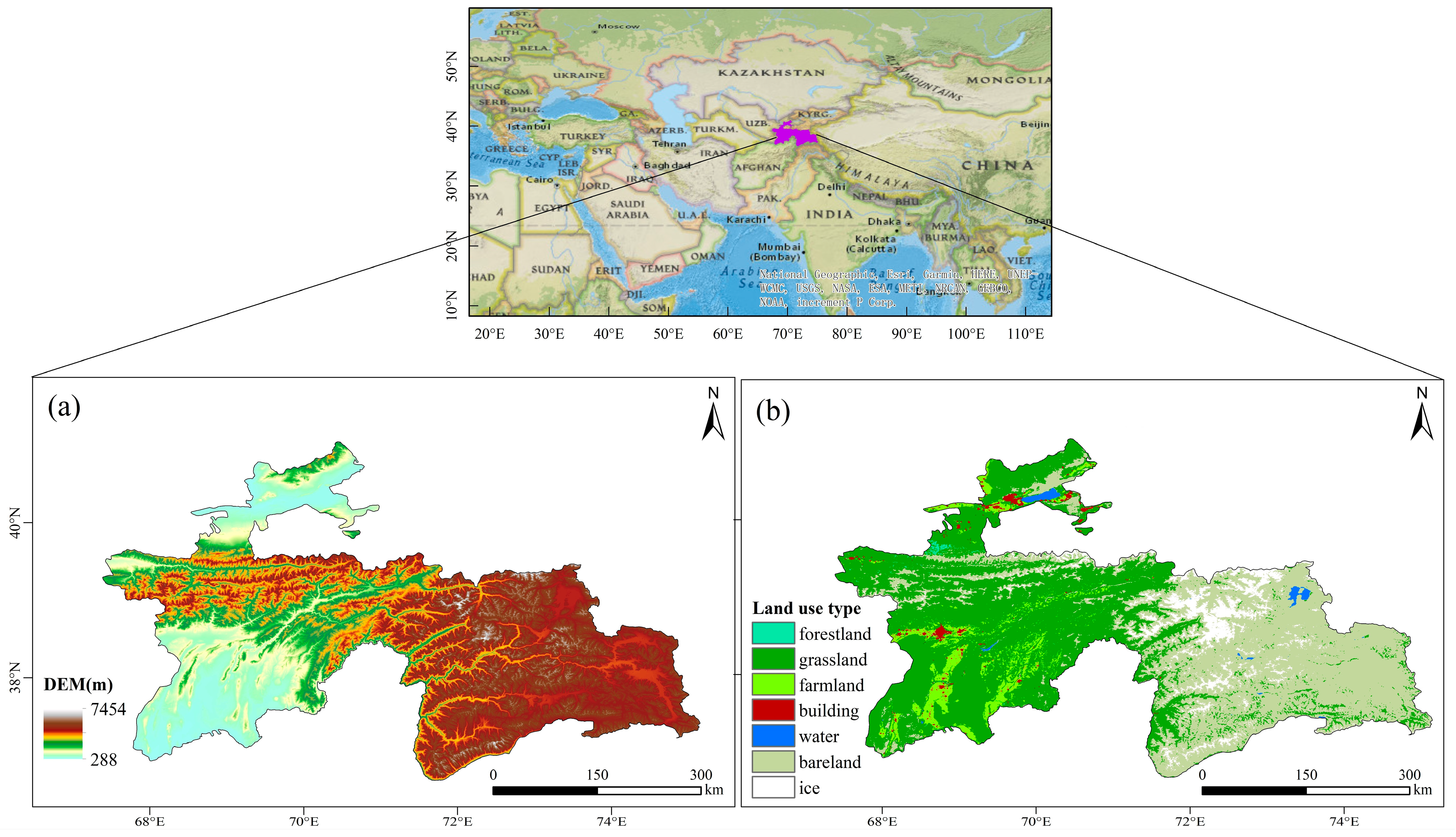


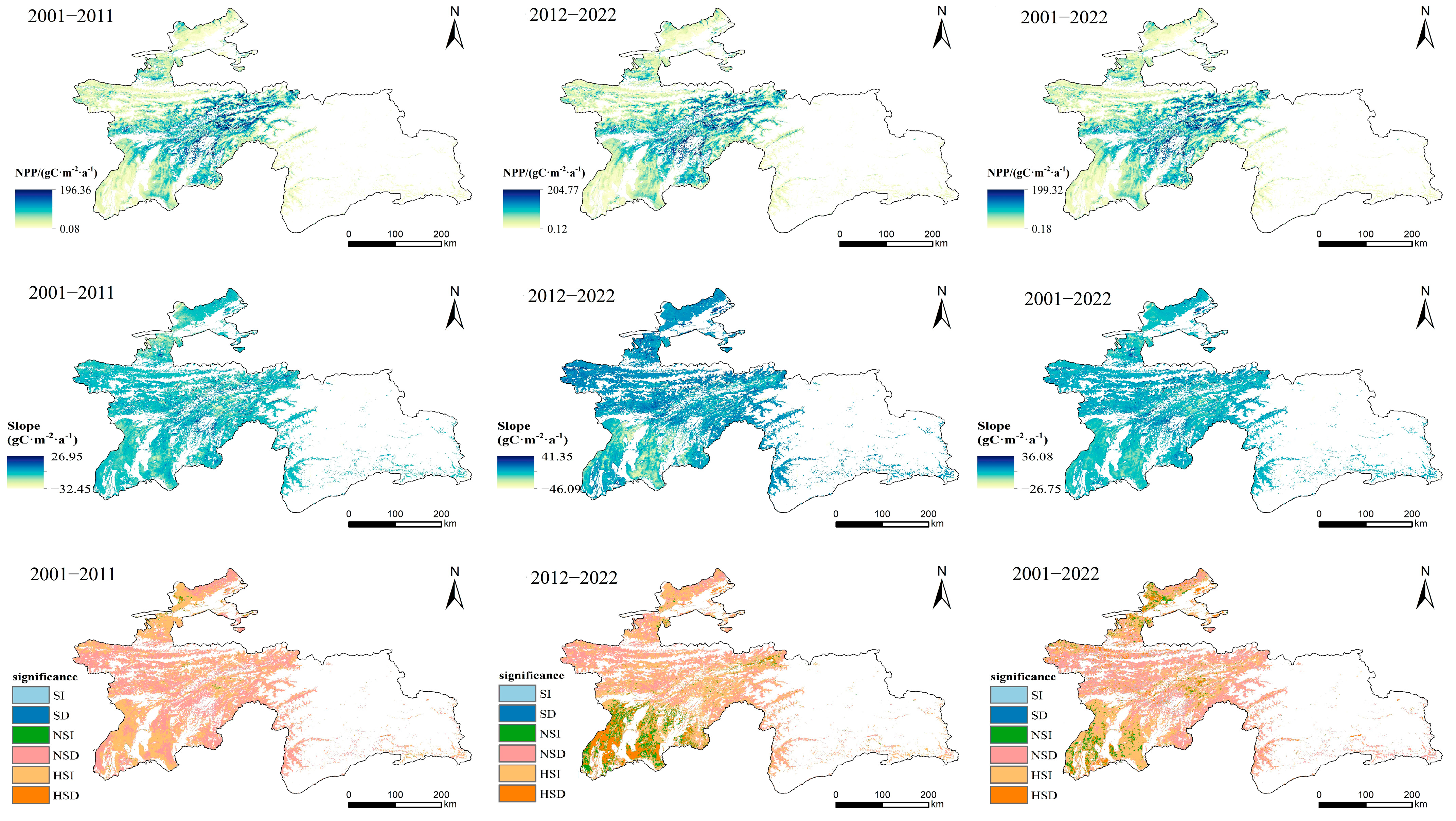
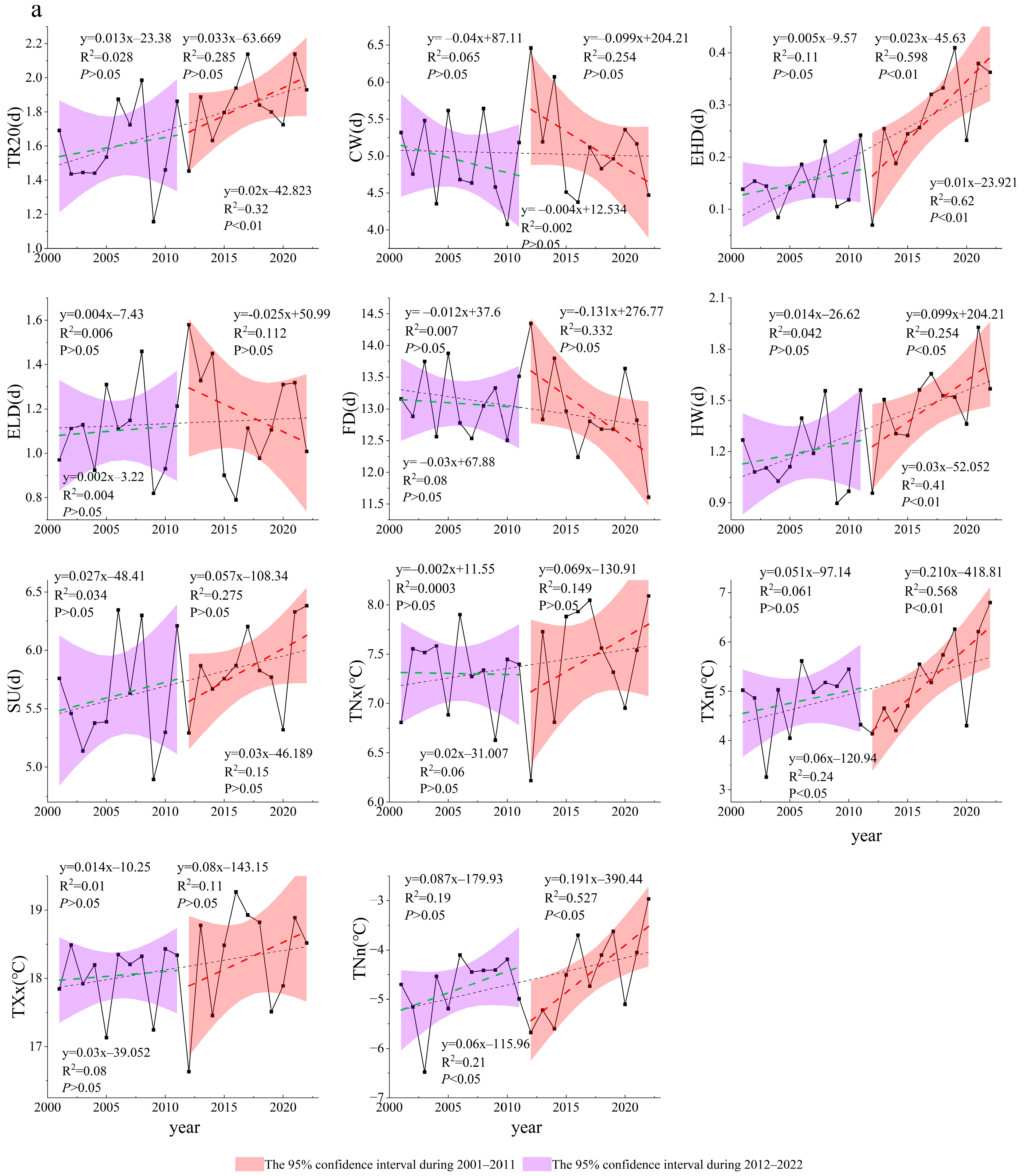
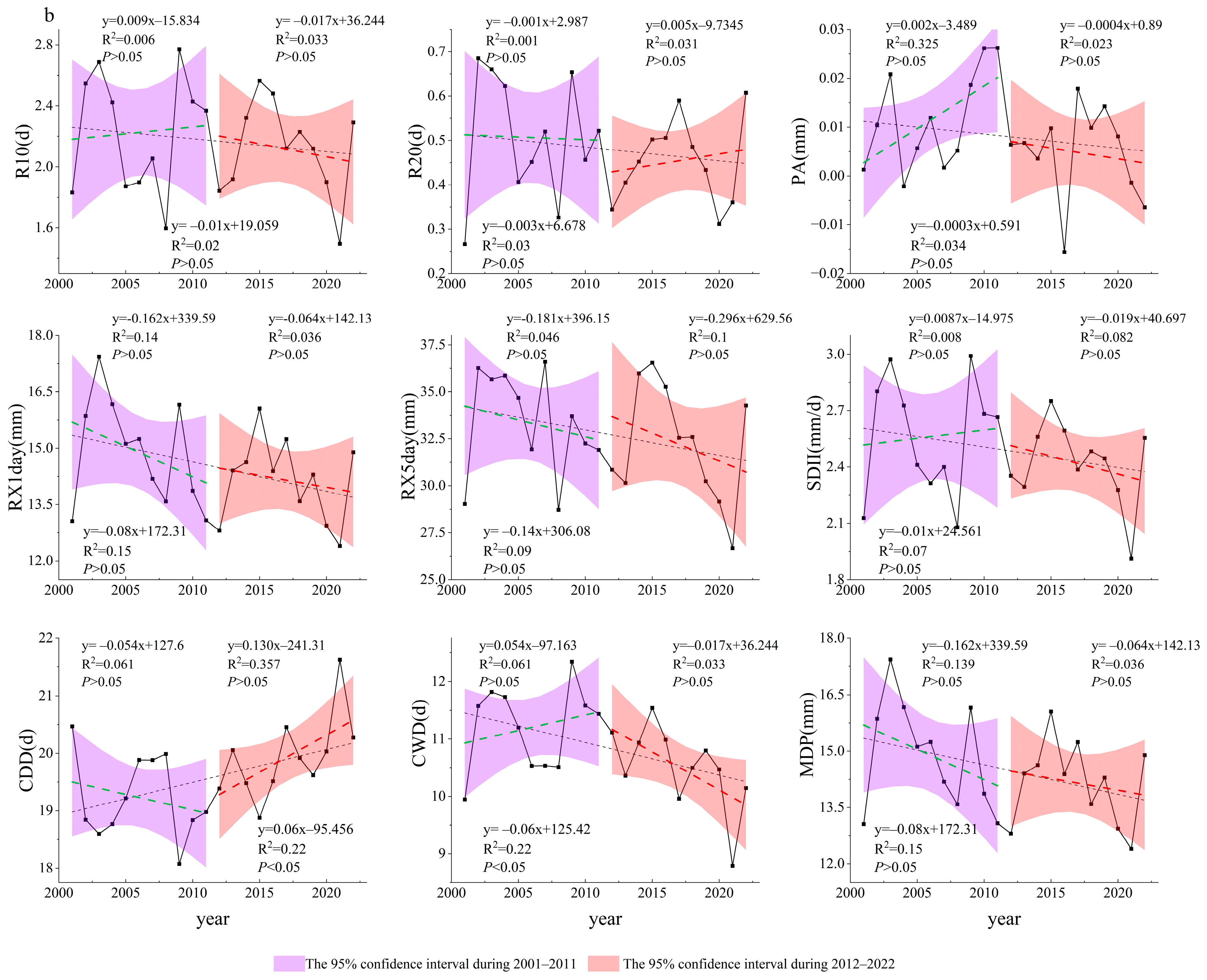
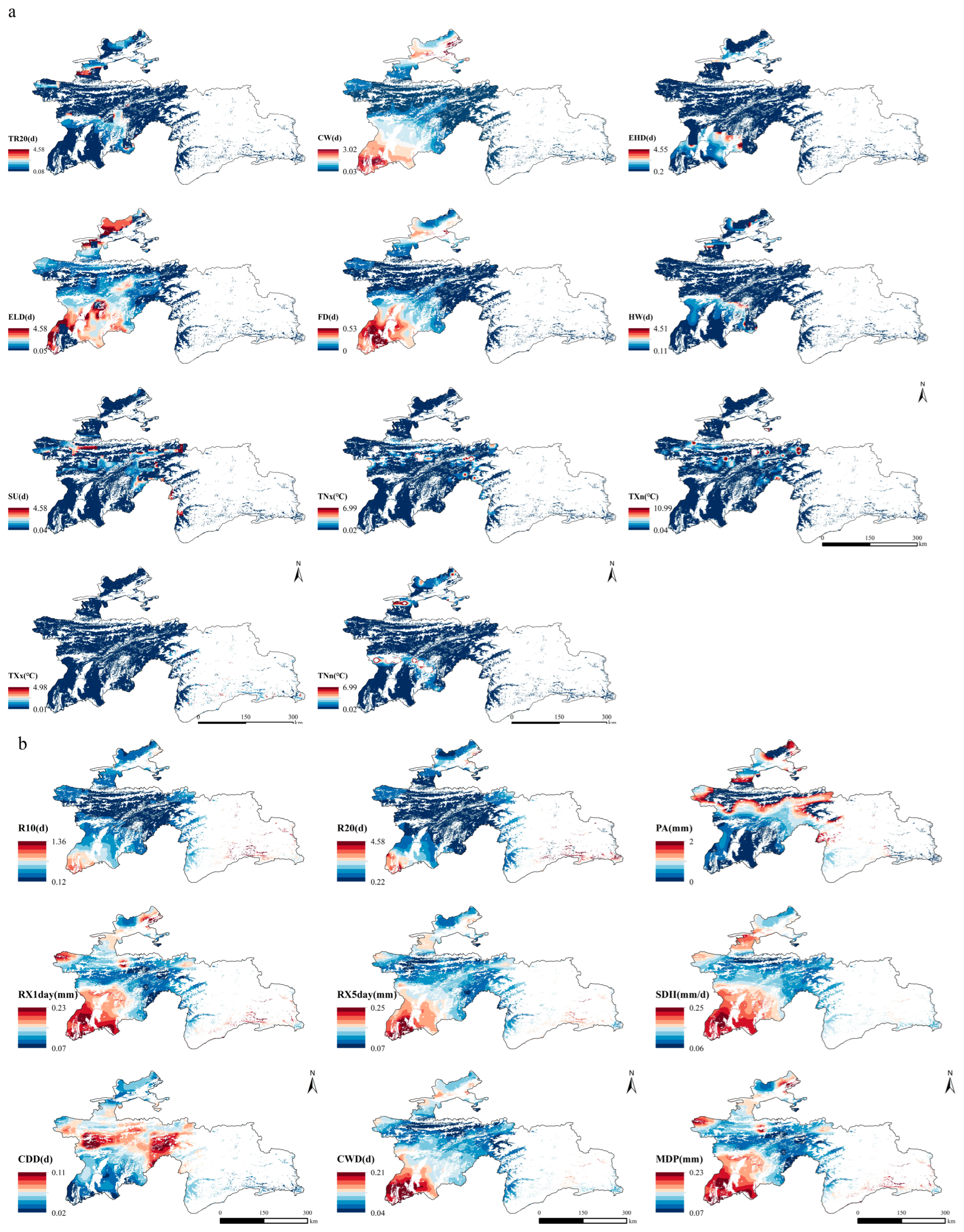
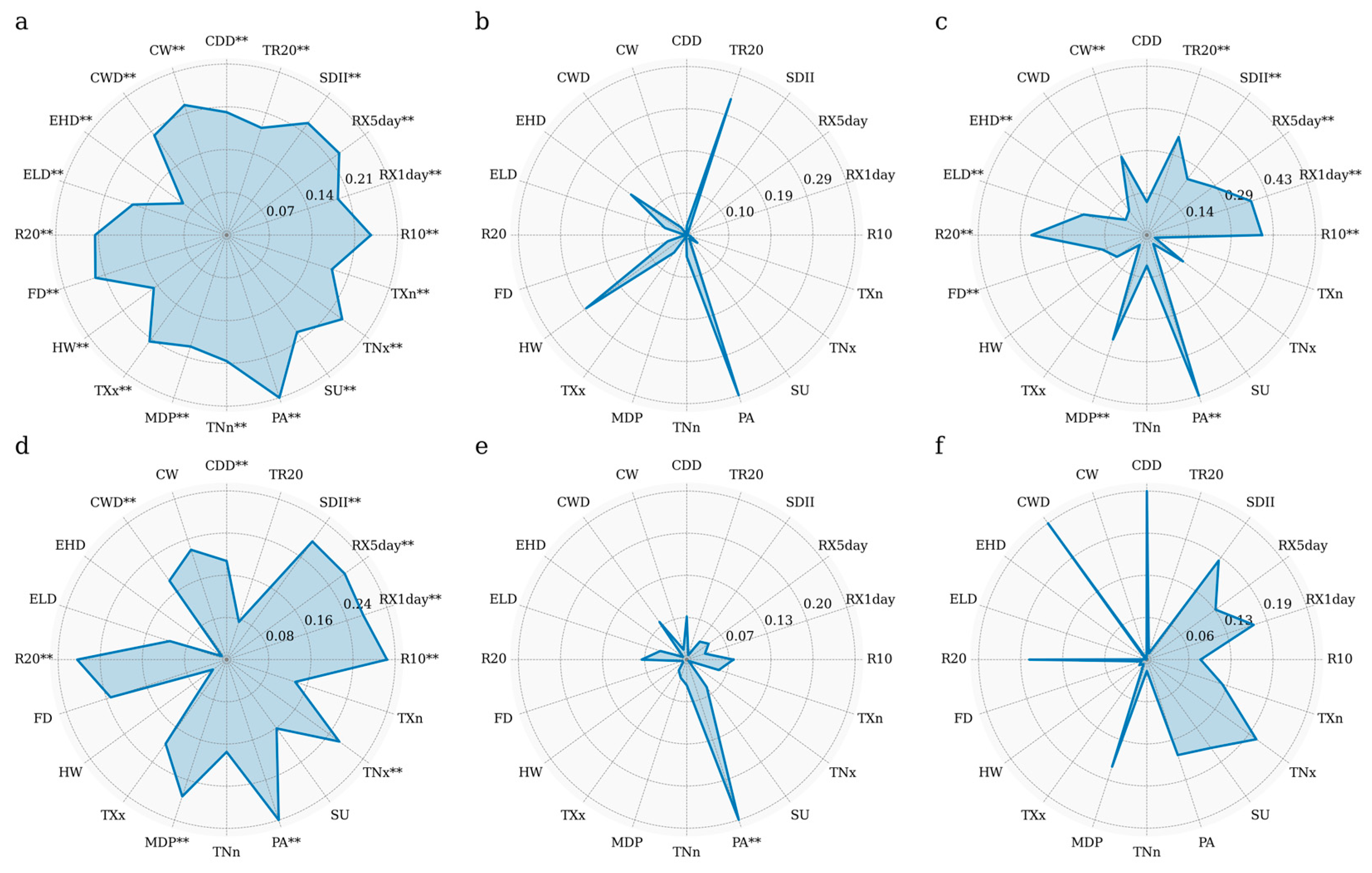
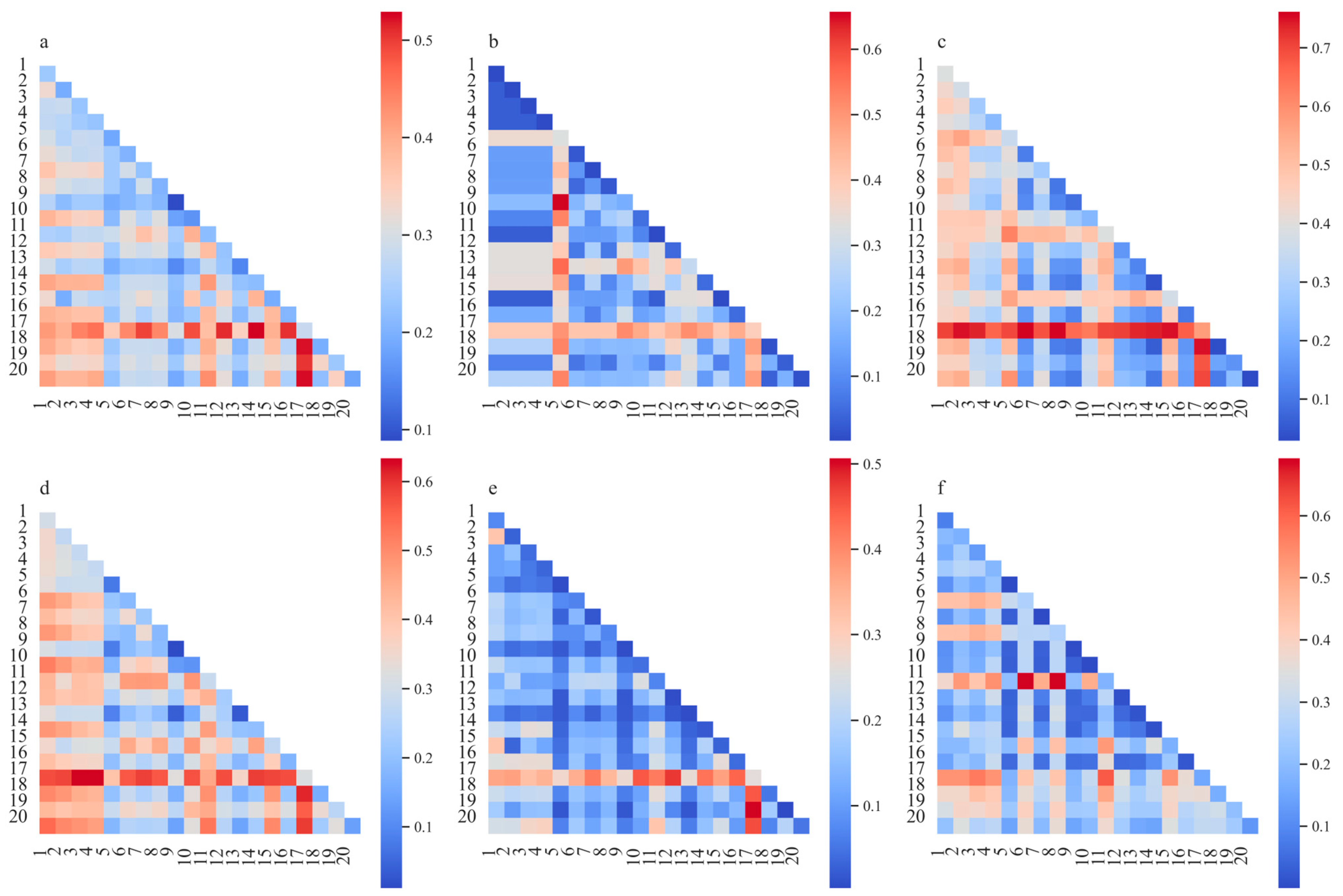
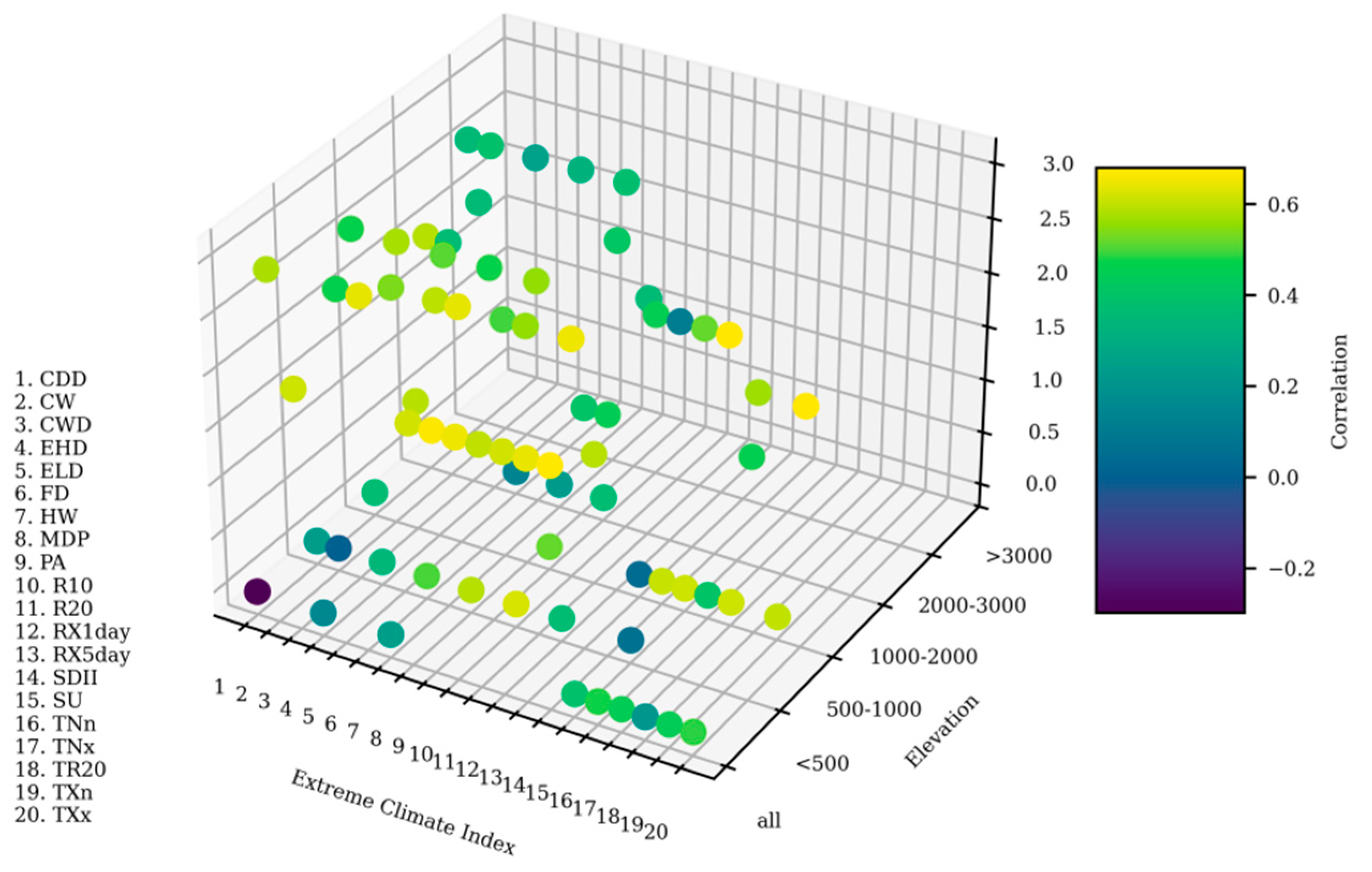
| Index Types | Descriptive Name | Indices | Definitions |
|---|---|---|---|
| Extreme temperature indices | Frost days | FD | Daily minimum temperature < 0 °C per month |
| Summer days | SU | Daily maximum temperature > 25 °C per month | |
| Min Tmin | TNn | The minimum daily minimum temperature per month | |
| Min Tmax | TXn | The minimum daily maximum temperature per month | |
| Max Tmin | TNx | The maximum daily minimum temperature per month | |
| Max Tmax | TXx | The maximum daily maximum temperature per month | |
| Hot nights | TR20 | Daily maximum temperature > 25 °C per month | |
| Heatwaves | HW | Daily maximum temperature > 35 °Cper month | |
| Cold waves | CW | Daily minimum temperature < −10 °C per month | |
| Extreme hot days | EHD | Daily maximum temperature > 40 °C per month | |
| Extreme cold days | ELD | Daily minimum temperature < −20 °C per month | |
| Extreme precipitation indices | Maximum one day precipitation | RX1day | Maximum daily precipitation per month |
| Maximum five-day precipitation | RX5day | Maximum 5-day consecutive precipitation | |
| Precipitation anomaly | PA | Daily precipitation-annual average precipitation | |
| Max precipitation | MDP | Maximum daily precipitation | |
| Heavy precipitation | R10 | Daily precipitation > 10 mm per month | |
| Very heavy precipitation | R20 | Daily precipitation > 20 mm per month | |
| Consecutive dry | CDD | Daily precipitation < 1 mm per month | |
| Consecutive wet | CWD | Daily precipitation ≥ 1 mm per month | |
| Simple daily intensity index | SDII | Monthly total precipitation/precipitation days |
| Interaction | Description |
|---|---|
| Weaken and nonlinear | q(x1 ∩ x2) < min(q(x1), q(x2)) |
| Weaken and univariate | min(q(x1), q(x2)) < q(x1∩x2) < max(q(x1), q(x2)) |
| Enhance and bivariate | q(x1 ∩ x2) > max(q(x1), q(x2)) |
| Independent | q(x1 ∩ x2) = max(q(x1), q(x2)) |
Disclaimer/Publisher’s Note: The statements, opinions and data contained in all publications are solely those of the individual author(s) and contributor(s) and not of MDPI and/or the editor(s). MDPI and/or the editor(s) disclaim responsibility for any injury to people or property resulting from any ideas, methods, instructions or products referred to in the content. |
© 2025 by the authors. Licensee MDPI, Basel, Switzerland. This article is an open access article distributed under the terms and conditions of the Creative Commons Attribution (CC BY) license (https://creativecommons.org/licenses/by/4.0/).
Share and Cite
Geng, Y.; Hisoriev, H.; Wang, G.; Ma, X.; Fan, L.; Mekhrovar, O.; Abdullo, M.; Li, J.; Li, Y. Time-Lag of Seasonal Effects of Extreme Climate Events on Grassland Productivity Across an Altitudinal Gradient in Tajikistan. Plants 2025, 14, 1266. https://doi.org/10.3390/plants14081266
Geng Y, Hisoriev H, Wang G, Ma X, Fan L, Mekhrovar O, Abdullo M, Li J, Li Y. Time-Lag of Seasonal Effects of Extreme Climate Events on Grassland Productivity Across an Altitudinal Gradient in Tajikistan. Plants. 2025; 14(8):1266. https://doi.org/10.3390/plants14081266
Chicago/Turabian StyleGeng, Yixin, Hikmat Hisoriev, Guangyu Wang, Xuexi Ma, Lianlian Fan, Okhonniyozov Mekhrovar, Madaminov Abdullo, Jiangyue Li, and Yaoming Li. 2025. "Time-Lag of Seasonal Effects of Extreme Climate Events on Grassland Productivity Across an Altitudinal Gradient in Tajikistan" Plants 14, no. 8: 1266. https://doi.org/10.3390/plants14081266
APA StyleGeng, Y., Hisoriev, H., Wang, G., Ma, X., Fan, L., Mekhrovar, O., Abdullo, M., Li, J., & Li, Y. (2025). Time-Lag of Seasonal Effects of Extreme Climate Events on Grassland Productivity Across an Altitudinal Gradient in Tajikistan. Plants, 14(8), 1266. https://doi.org/10.3390/plants14081266







